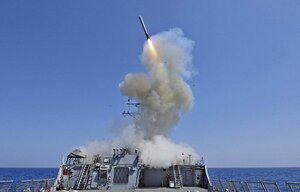What might Syria strike look like? Libya operation could hold clues
Four US Navy guided missile destroyers, along with British warships, are positioned in the Mediterranean Sea to attack Syrian military targets. It's a cat-and-mouse game, as Syria likely places decoys.

The guided-missile destroyer USS Barry launches a Tomahawk cruise missile from the ship's bow in the Mediterranean Sea in 2011. The Barry is one of four US destroyers currently deployed in the Mediterranean Sea equipped with long-range Tomahawk missiles that could potentially be used to strike Syria.
Jonathan Sunderman/US Navy/Reuters/File
If the United States attacks Syria, it’s likely to be much like the opening hours of the multinational military effort which ousted Muammar Qaddafi from power in Libya in 2011 – wave after wave of ship-based cruise missiles, launched at night and with considerable accuracy at military targets.
But as the US Navy positions missile-armed warships, the regime of Syrian President Bashar al-Assad likely is hiding moveable targets and deploying decoys in what one retired battleship commander calls “the most intense, rapid moving cat-and-mouse game yet seen in strike warfare.”
British naval vessels, including submarines regularly in the area on the way to the Suez Canal, are likely to be involved as well as US Navy ships.
“A Royal Navy nuclear-powered submarine is said to be in the region while a number of warships recently left Britain for exercises in the Mediterranean,” reports the Telegraph newspaper. “Military sources suggested the early hours of the 2011 campaign against Col. Muammar Qaddafi could form a template for any operation. The Libya campaign began with a blitz of Tomahawk cruise missiles from US warships and from a British Trafalgar Class submarine.”
British warships may be ready and moving into position, but most of the naval attack would come from the US Sixth Fleet, which has four guided missile destroyers – the USS Gravely, USS Mahan, USS Barry, and USS Ramage – operating in the eastern Mediterranean Sea as they wait for the order to launch. Attack submarines carrying cruise missiles are believed to be in the Mediterranean as well.
“Targets would be headquarters, command posts, air defense, air fields, and some fielded forces, while avoiding places that Bashar himself is likely to lurk,” predicts John Pike, director of GlobalSecurity.org, who estimates such an attack to total 150-200 Tomahawk cruise missiles.
Unlike Libya, where the goal was to get rid of dictator Qaddafi, that would not be the case with Mr. Assad.
“It seems the challenge is to do enough to not look silly, while not doing so much as to destabilize the regime,” says Mr. Pike.
“Most assuredly they would not be targeting poison gas facilities or stocks,” adds Mr. Pike in an e-mail exchange, because that could spread poisonous chemicals into civilian areas.
Ship-based Tomahawk missiles, which have been part of the US arsenal since 1983, had their combat debut during the first Gulf War in 1991. Since then, they’ve been used in Sudan, Afghanistan, Libya, and Yemen and again in Iraq during the “shock and awe” air attack on Baghdad at the start of the US invasion in 2003. All told, some 2,000 have been fired in combat.
Weighing about 3,000 pounds (depending on configuration), each missile is about 20 feet long and 20 inches in diameter and carries a warhead of several hundred pounds. The US Navy has more than 3,000 Tomahawks on its warships or in storage, according to StrategyPage.com.
Tomahawks fly at very low level, making it difficult for enemy radar to detect them, and their range and accuracy allow them to be fired from hundreds of miles offshore. But more sophisticated air-defense systems developed and deployed in recent years – including those flight tested by Russia – have put them at greater risk.
“It is quite clear that the president must authorize some kind of strike,” says retired US Navy Capt. Larry Seaquist, a former battleship commander and Pentagon strategist who predicts sea-based missile strikes, including from submarines, will be fired at targets in Syria. “But with every hour of delay the Syrian government is able to disperse and hide their forces and prepare their air defenses.”
“I’d also expect that they may deploy decoys and dummy targets – something that Saddam Hussein’s army did very skillfully” in Iraq, adds Captain Seaquist in an e-mail exchange.
“So what is likely going on right now is an intense effort by us to track the Syrian attempts to hide and continuously update our own targeting,” says Seaquist. “This may be the most intense, rapid moving such cat-and-mouse game yet seen in strike warfare.”

